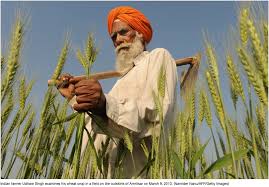Growing supply glut threatens worse to come for restive Indian farmers

MUMBAI Bountiful monsoon rains are unlikely to lift India’s rural economy this year, and may instead compound the woes of millions of debt-ridden farmers who are struggling with low prices amid a glut of produce such as lentils, oilseeds and cereals.
The South Asian nation is still carrying a huge inventory of food grains from last year’s record harvest as exports were hit by an appreciating rupee, falling global prices and restrictions on overseas shipments.
Another bumper harvest could accelerate the price slide and stoke discontent among farmers that has triggered protests in the big agrarian states of Maharashtra and Madhya Pradesh, where police shot dead five protesting farmers this week.
Three years into his term, Prime Minister Narendra Modi remains popular and has no credible challenger. Yet unrest has flared in states ruled by his Bharatiya Janata Party (BJP), catching regional leaders flat-footed and providing a reality check on Modi’s promise to double farmers’ incomes over the next five years.
“The next year will be challenging for the government in ensuring farmers get decent realisation,” said Harish Galipelli, head of commodities and currencies at Inditrade Derivatives & Commodities in Mumbai.
Farmers in Madhya Pradesh and Maharashtra are demanding better prices for their produce and billions of dollars in debt relief after the new BJP government in India’s most populous state, Uttar Pradesh, recently announced a $ 5.6 billion loan write-off for farmers.
Yet experts say such loan waivers amount to quick fixes that cannot compensate for flaws in farm policies, which have encouraged higher production of crops previously in short supply but offered scant protection on prices.
Many farm commodities are trading below support prices set by the government. That is because the government only commits serious sums to buying wheat and rice, but not other crops that enrich the diet of India’s 1.3 billion people.
Prices will fall further unless exports are revived, said Galipelli, adding “production has jumped but local demand hasn’t risen in the same proportion”. Ample world supply is likely to persist, predicts agribusiness giant Cargill Inc.
“There is no export parity right now. Even after the recent correction in oilmeal prices, Indian supplies are expensive,” said B.V. Mehta, executive director of the Solvent Extractors’ Association (SEA), a Mumbai-based trade body.
Indian grains production reached an all-time high of 273.38 million tonnes in the latest crop year, on record output of rice, wheat, oilseeds and pulses. But exports failed to revive, depressing local prices of corn < NMZc1>, wheat, soybean and turmeric.
Exports of key farm commodities fell by a quarter in 2015/16 to $ 16.07 billion due to drought, and failed to revive in 2016/17 despite the recovery in output.
RURAL DISTRESS
A rising population, shrinking farm plots and increasing indebtedness among farmers have all hit India’s vast rural hinterlands. Farming accounts for 14 percent of gross domestic product – down from 47 percent at independence 70 years ago.
Nearly a third of rural households are in debt, owing an average of more than 100,000 rupees ($ 1,560). Many farmers lack access to formal credit, forcing them to borrow dearly from money lenders or relatives.
To mitigate this distress, state and central governments have ramped up purchases of red chilli, turmeric, corn, onion, sunflower, pigeon peas and groundnut from farmers.
Still, farmers such as Sanjay Shinde from Maharashtra’s Nashik district are unhappy. “If Uttar Pradesh can waive all farmers’ debts, then why not Maharashtra?” he asked.
Reserve Bank of India Governor Urjit Patel has warned that such loan waivers – forecast by BofA Merrill Lynch to reach $ 40 billion – would weaken already-strained state finances. “It is a path that we need to tread very carefully,” he said this week.
Analysts and traders say good monsoon rains – forecast at 98 percent of the long-term average – will only complicate matters unless supplies are adequately managed.
“There is an urgent need to restrict imports and promote exports. That’s how one can bring down the inventory level of food grains,” says Nitin Kalantri, a miller at Latur in Maharashtra.
“Otherwise in the next season we will have much a bigger problem. And much bigger farmers’ protests.”

